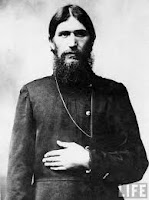In the great actions of 1914 and 1915 Britain had been a minor player
alongside the enormous armies of Germany, Austro-Hungary and France on the
battlefields of the Western and Eastern Fronts. The costly Somme campaign of 1916 had
changed all that, both in perception and reality. The full impact of British
Imperial capacity alongside the attritional losses to the other major players
made Britain's strategy for the war in 1917 just as important - and not solely
on the high seas. The previous post has noted new PM Lloyd George's impact -
his powerful war cabinet of five persons and his creation of new departments -
on management of the war effort. In time this hub of government would become
overloaded and exhausted, but for now, the raft of initiatives created a
positivity that contrasted with the wary workings of Asquith's cabinet.
The PM flew, in rapid succession, to Paris and Rome. He despatched Lord
Milner, Minister without Portfolio to St. Petersburg. He pressed for more
frequent Allied conferences, and involvement of the Dominion leaders.
 |
The Imperial War Cabinet at 10 Downing St. 1917
Note the demographic. |
It was Lloyd George’s initiative to convene
an Imperial conference, to be held in London in March 1917, and to create an
Imperial War Cabinet. Empire conferences had been held periodically in London
since 1887, usually tagged on to other visits or major royal occasions.
Initially styled as ‘Colonial’, they became ‘Imperial’ conferences in 1907, and
at the George V coronation event in 1911 they received further enhancement
in status and profile.
However, it was Lloyd George’s first such
conference in 1917, and he argued for greater involvement of the Dominions, not
only in conduct of the war, but also in shaping the unpredictable post-war
world. Up until this point, all policy decisions (with the exception of the
quasi-autonomous Indian government) had been made by London. Out of this month
long convention arose Lloyd George’s Imperial War Cabinet, which – in addition
to the 5 British members - included the Prime Ministers of Canada,
Newfoundland, Australia, New Zealand and South Africa plus two representatives
from India. It was at this conference that the term ‘Commonwealth’ was coined
for the first time. It was indeed a pointer towards post-war changes.
The divisive tensions over conscription of
the 1915 Coalition government were replaced by a commitment to national service.
However, superimposing this on the voluntary system and Lord Derby’s half-way
house scheme of the past two years was a challenge. Men previously rejected on
health or occupation grounds were re-assessed against less stringent criteria,
but there were many individuals left unhappy with decisions applied.

Even before the declaration of unrestricted
warfare, the increased U-boat activity was hitting British imports hard. In
February Lloyd George imposed restrictions on all imports not directly related
to the war effort. In that month he announced government control over coal
production – a move that would have been unthinkable two years earlier. Lord
Devonport was appointed as National Food Controller to address the worsening
shortage of grain, sugar and potatoes. Britain was in a much better position
than Germany and Austria in this regard, but the prospect of escalating losses
of shipping was a serious matter. Voluntary rationing was encouraged, as was
maximising agricultural production on all types of open land.
Britain was running out of money as well as
materials. In February Bonar Law, the new Chancellor, reported that in the
current financial year, the daily cost of prosecuting the war had risen by
nearly 20% to almost £6million per day (it would do so again in the next few
months). His first budget in April projected an eye watering deficit, nearly
three times higher than the projected total income. Matters were helped by a
£100 million donation from the aforementioned Government of India, but it took
a massive war bond scheme – the Four and a Half Percent War Loan (to which 8
million people subscribed) – to stump up the cash to keep Britain solvent. The
USA’s entry to the war improved the outlook for later in the financial year.
With all these matters, and the enduring
effects of the terrible losses in the Somme campaign, the British public
appreciated that backs were being pushed towards the wall. This, and the
increases in government control of production, meant that there was less
industrial unrest than in the earlier stages of the war. However tensions
remained, especially over the adoption of unskilled labourers and women into
jobs previously protected as skilled trades. One strike by engineers involved a
quarter of a million men, and many arrests.
Everyone was feeling the pressure.
Churchill writes glowingly of the PM's performance in these months. Although he was strongly supported by the press
and public, Lloyd George had a lot to do to win the backing of parliament. He
was head of a coalition, but not leader of a political party, and he had made
numerous enemies en route to the top. At Churchill’s suggestion (sic) he
convened a secret session of the House of Commons in May, and was able to win
strong backing in a debate with frank exchanges about the realities of the war situation.
Churchill lists Lloyd George's greatest achievements in this period as the Imperial War
Cabinet; unified command of the Allies; the Atlantic convoy system, and the advances
in Palestine (see subsequent posts for the last two).







